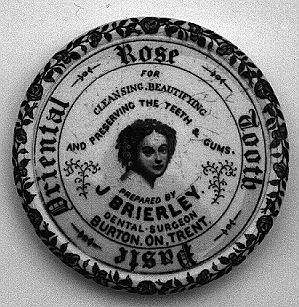
TOOTHPASTE & POT LIDS
 The
history of tooth care goes back to 300-500 years before the birth of Christ
and the ancient civilisations of India and China. A learned Chinaman by
the name of Huang-Ti studied the care of teeth and suggested that pain
in the mouth could be cured by sticking gold and silver needles into different
parts of the jaw. Maybe Mr Huang-Ti was the world's first dentist !! Moving
onto another ancient civilisation we find an early and disgusting recipe
for toothpaste. Those who hate the chore of daily brushing their teeth
can count themselves lucky not to be living in Ancient Egypt. The Egyptian
toothpaste recipe called for "powdered ashes of hooves of oxen, myrrh,
powdered burnt egg shells and pumice!" Directions called for these
ingredients to be thoroughly mixed together but no mention is made of
a toothbrush. Presumably the Egyptians rubbed this mixture onto their
teeth with fingers, for the toothstick, an early forerunner of the toothbrush
had not yet been invented !!
The
history of tooth care goes back to 300-500 years before the birth of Christ
and the ancient civilisations of India and China. A learned Chinaman by
the name of Huang-Ti studied the care of teeth and suggested that pain
in the mouth could be cured by sticking gold and silver needles into different
parts of the jaw. Maybe Mr Huang-Ti was the world's first dentist !! Moving
onto another ancient civilisation we find an early and disgusting recipe
for toothpaste. Those who hate the chore of daily brushing their teeth
can count themselves lucky not to be living in Ancient Egypt. The Egyptian
toothpaste recipe called for "powdered ashes of hooves of oxen, myrrh,
powdered burnt egg shells and pumice!" Directions called for these
ingredients to be thoroughly mixed together but no mention is made of
a toothbrush. Presumably the Egyptians rubbed this mixture onto their
teeth with fingers, for the toothstick, an early forerunner of the toothbrush
had not yet been invented !!
From Ancient Egypt we move to Ancient Greece and Rome, where both toothpastes and dental care were developed. These civilisations produced the first lead instrument to help extract teeth and were also the first to wire loose teeth together and support artificial teeth with gold wire. In AD1000 we find further references to toothpastes in writings from Persia . It would seem that knowledge was developing as there were warnings about hard and abrasive toothpowders. Mention was made that the best powders for toothpaste were made from burnt hartshorn, burnt shells of snails and oysters and burned gypsum. Other early recipes before modern times included dried animal parts, herbs, honey and minerals. One formula for strengthening teeth included green lead, verdigris, incense, honey and powdered flintstone.
In the seventeenth century dentrifice was being sold as a powder and an advert from the newspaper Mercurius Politicus in 1660 promoted the use of Mr. Robert Turner's Most Excellent and Approved DENTRIFICE. In Georgian times the poor would have rubbed salt on their teeth. Some people made up their own dentrifice and rubbed the resulting powder on their teeth with a toothstick with a rag over one end - the forerunner of course of the toothbrush. The first toothbrush would not appear until the more solid toothpaste or tooth soap became available. Toothpaste and powders first appeared in printed pots round the 1860's. By the 1880's many chemists were making their own toothpastes, packaged in their own printed pots. The date of the first manufactured toothpaste was 1873 but it was not until 1896 that a product similar to that on the market today appeared. It became available in collapsible tubes in 1890.In 1914 it appeared in a metal tube for the first time,
The two most popular toothpastes in late Victorian times are not even sold today. Areca Nut and Cherry Toothpaste were actually made to the same formula. Cherry toothpaste became red or pink by the addition of carmine but no cherry flavouring was added. The word cherry came only from the colour of the paste. The Indian areca or betel-nut and the cherry were popular subjects for the designers of the toothpaste lids. Some areca nut lids also carried illustrations of Indian buildings or mosques and palm trees- the areca nut was itself obtained from a type of palm tree. Some pot lids were decorated with cherries or cherry blossom - even though there was no cherry flavouring. Adding colour to the paste also allowed further romantic descriptions to boost sales -and such toothpastes as White Rose, Coral, Tomato, Carnation, Damask Rose were created. Areca Nut without any colouring could always be called White Cherry ! Some toothpastes had names which would seem strange today - including carbolic and antiseptic toothpaste. High Street Chemists were involved in often cut-throat competition and this is one of the main reasons why so many different toothpastes were created - each chemist hoped their own toothpaste would become the most popular.
The number and varieties of toothpaste being manufactured by high street chemists started to decline in Edwardian times. Large scale manufacturing chemists were able to supply such outlets with mass produced toothpaste sold in metal tubes. After the first world war, few chemists were still selling toothpaste in the small printed pots. Toothpaste today is chiefly packaged in plastic rather than metal tubes and the choice of flavours is fairly uniform and nothing like the exotic and varied flavours that our ancestors would have known 100 years ago. Mint has replaced areca nut as the most popular flavouring while the exotic flavours are now provided for children !
PLEASE NOTE : This article first appeared in BYGONES magazine Volume 3. No.2 - Britain's MOST informative ever bottle magazine which has now transfered to the internet and is responsible for this website